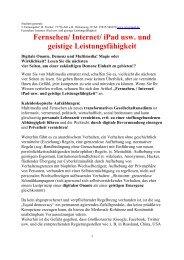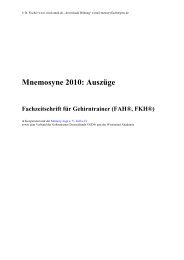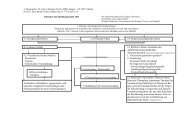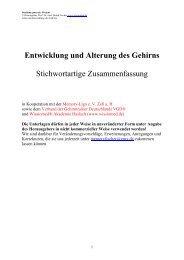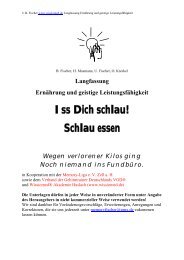16. Soziale intelligenz, was ist das? (Stichpunkte ... - WissIOMed
16. Soziale intelligenz, was ist das? (Stichpunkte ... - WissIOMed
16. Soziale intelligenz, was ist das? (Stichpunkte ... - WissIOMed
Sie wollen auch ein ePaper? Erhöhen Sie die Reichweite Ihrer Titel.
YUMPU macht aus Druck-PDFs automatisch weboptimierte ePaper, die Google liebt.
Studium generale<br />
© Herausgeber: B. Fischer, 77736 Zell a.H, Birkenweg 19 Tel: 07835-548070 www.wisiomed.de<br />
<strong>Soziale</strong> Intelligenz<br />
Mayer, J. D., DiPaolo M, Salovey P. (1990). Perceiving affective contnent in ambigous visual stimuli: A component of emotional intelligence. J<br />
Peronal. Assessment 54, 772-781<br />
Mayer, J. D., Gehr G (1996. Emotional intelligence and the identification of emotion. Intelligence 22, 89-113<br />
Mayer, J. D., Salovey P. (1997). What is emotional intelligence In: Salovey P, Sluyter DJ (eds.). Emotional development and emotional<br />
intelligence. Educational implications (pp.3-31) N.Y. Basic Books<br />
Mayer, J. D., Salovey P, Caruso DR (2000). Models of emotional intelligence. In Sternberg RJ (ed.). Handbook of intelligence (pp. 396-420)<br />
N.Y. Cambridge University Press<br />
Mayer, J. D., Salovey P, Caruso DR, Sitareios G (2003). Measuring emotional intelligence with MSCEITV2.0. Emotion 3, 97-105<br />
Mayer, R. E.: Techniques that foster active reading strategies. Paper presented at the annual meeting of the American educational research<br />
association, Washington (1987)<br />
Mayer, R. E., Revlin, R.: An information processing framework for research on human reasoning. In: Revlin, R., Mayer, R. E. (eds.): Human<br />
reasoning. N. Y.: Wiley (1978), 1-32<br />
Mayne, T. J.: Negative affect and health: The importance of being earnest.Cognition and emotion, psychology press Vol 13, No 5 (1999), 601-<br />
635<br />
Menzel EW Jr, Premack D, Woodruff G: Map reading by chimpanzees. Folia Primatol (Basel). 1978;29(4):241-249<br />
Mesoudi A, Whiten A, Dunbar R: A bias for social information in human cultural transmission. Br. J. Psychol 2006 Aug;97(Pt3):405-423<br />
Meyer-Lindenberg A: Psychology. Trust me on this. Science. 2008 aug 8;321(5890):778-780<br />
Meyer-Lindenberg A: Impact of prosocial neuropeptides on human brain function. Prog Brain Res. 2008;170:463-470<br />
Meyer-Lindenberg A, Mervis CB, Berman KF: Neural mechanism in williams syndrome: a unique window to genetic influences on cognition<br />
and behavior. Nat Rev Neurosci 2006 May;7(5):380-393<br />
Meyer-Lindenberg A, Hariri AR, Munoz KE et al.: Neural correlates abnormal social cognition in Williams syndrome. Nat Neurosci. 2005 Aug;<br />
8(8):991-993<br />
Michel K: Gruppen machen schlau Die Zeit 6. November 2008, Nr 46, S. 44<br />
Miegel M: Exit. Wohlstand ohne Wachstum. Propyläen 2010<br />
Miller G: Reflecting on another’s mind. Science 308, 2005, 945-947<br />
Mischel W: in: Oerter R & Montada L. (Hrsg.) (2002). Entwicklungspsychologie, Weinheim: Beltz/PVU<br />
Miyazaki T, Ishikawa T, Nakata A et al.: (2005). Association between perceived social support and Th1 dominance. Biol Psychol 70, 30-37<br />
Moffitt TE, Arseanault L, Belsky D et al.: A gradient of childhood self-cotnrol predicts health, wealth, and public safety. PNAS Early Edition<br />
www.pnas.org/CGI/doi/10.1073/pnas.1010076108 Doi: 10.1073/pnas.1010076108<br />
Mostkofsky E, Maclure M, Sherwood JB: Risk of acute mycardial infarction after death of a significant person in one’s life: The determinants of<br />
MI onset study. Circulation 2012 Jan 9 Epub ahead of print<br />
Müller MM: Zu Nutzenbewertung des Gesundheitswesens. In: Hensen P, Kölzer C (HRSG.): Die gesunde Gesellschaft, VS Verlag, Wiesbaden<br />
2011<br />
Müller-Jung J: <strong>Soziale</strong> Köpfe. Das Kind denkt, der Affe lenkt: Verliert <strong>das</strong> Tier den Anschluss FAZ 12.09.2007, Nr. 212 S. N1<br />
Müsseler, J., Prinz, W.: Allgemeine Psychologie. Spektrum, Heidelberg (2002)<br />
Nägerl V, Köstinger G, Anderson JC, Martin KA, Bonhoeffer T: Protracted synaptogenesis after activity-dependent spinogenesis in hippocampal<br />
neurons. J Neuroscience 2007 Jul 25;27(30):8149-8156)<br />
Neisser, U. et al: Intelligence: Knowns and Unknowns. American Psycholog<strong>ist</strong> 51 (1996), 77-101<br />
Neisser, U.: Visual search. Scientific American 210 (1964), 94-102<br />
Neisser, U.: The rise and fall of the sensory reg<strong>ist</strong>er. The behavioral and brain science 6 (1983), 35<br />
Neisser, U.: Cognitive psychology. New York: Appleton-century-crofts (1967)<br />
Neisser, U.: Cognition and realitiy. San Francisco: Freeman (1976)<br />
Neisser, U. et al: Intelligence: knowns and unknowns. American Psycholog<strong>ist</strong> 51 (1996), 77-101<br />
Apr. 1;23(4):391-396 28. 10.2007, Nr. 43, S. 36<br />
O’Brien E, Ellworth PC: More than skin deep: visceral states are nor projected ontobsimilar others. Psychol Sci 2012<br />
O’Conell SM: Empathy in Chimpanzees: Evidence for Theory of Mind) Primates 1995, 36(3):397-410<br />
Oerter R & Montada L. (Hrsg.) (2002). Entwicklungspsychologie, Weinheim: Beltz/PVU: Belohnungsaufschubparadigma von Walter Michel<br />
Pachur T: Ohne Fleiß zum Preis. Gehirn & Ge<strong>ist</strong> 7-8_2010, 18-23<br />
Pagel M: Am Anfang war <strong>das</strong> Plagiat. Gehirn und Ge<strong>ist</strong>. 10._2012, 48-51<br />
Pagel M: Wired for culture. The natural h<strong>ist</strong>ory of human cooperation. Penguin Press, London 2012<br />
Paulhus D, Williams KM: The dark triad of personality: Narcissm, Machiavelianism, and psychopathy. Journal of Research in Personality, 2002,<br />
36, 556-563<br />
Pennekamp J: Wissenswert: Festanstellung oder Selbstständigkeit Warum Menschen zu Unternehmern werden, war Forschern lange ein Rätsel.<br />
Drei Ökonomen zeigen jetzt: Es <strong>ist</strong> alles eine Frage der Alternativen. Handelsblatt, 05.01.2011, Nr. 4, S18.; s.a. Berkhout P, Hartog J, Praag van<br />
M: et al.: It’s the Opportunity Cost, Stupid! How self-Employment Responds to Financial Incentives of Return, Risk and Skew. IZA Discussion<br />
Paper No.6166 (November 2011)<br />
Pérez-Barbeira FJ, Gordon IJ: Grgariosness increases brain size in ungulates. Oecologia. 2005 Aug;145(1):41-52<br />
Perner J (1991): Understanding th Representational Mind (MIT Press, Cambridge, MA)<br />
Petermann F et al: Verhaltenstraining in der Grundschule. Ein Präventionsprogramm zur Förderung emotionaler und sozialer Kompetenzen.<br />
Hogrefe., Göttingen, 2007<br />
Peters AK: Warum wir fühle, <strong>was</strong> wir fühlen. Der Lion Dezember 2007, S. 22-27<br />
Petri, H. L., Mishkin, M.: Behaviorism, cognitivism and the neuropsychology of memory.American Scient<strong>ist</strong> 82 (1994), 30-37<br />
Petri, C.: Entstehung und Entwicklung kreativer Werbeideen: Verbale und visuelle Assoziationen als Grundlage der Bildideenfindung für eine<br />
erlebnisbetonte Werbung. Physica Verlag, Heidelberg (1992), 11<br />
Piff PK, Stancato DM, Coté S et al.: Higher social class predicts unethical behaviour. PNAS SA 201 Mae 13;109(11):4086-4091<br />
Pinker S: Colloquium paper: the cognitive niche: coevolution of intelligence, sociality, and language. PNAS USA 2010 May 11;107 Suppl<br />
2:8993-8999<br />
Pinker S: The cognitive niche:Coevolution of intelligence, sociality, and language. http://www.pnas.org/content/107/suppl.2/8993.long<br />
Pinker S: The cognitive niche: Coevolution of intelligence, sociality and language. PNAS USA 2010; 107: 8993-8999<br />
183







